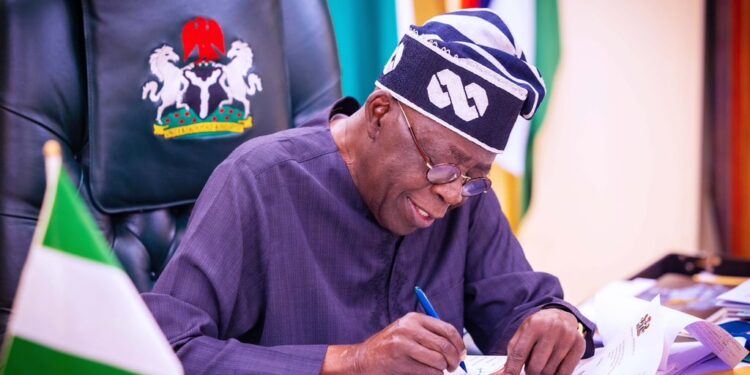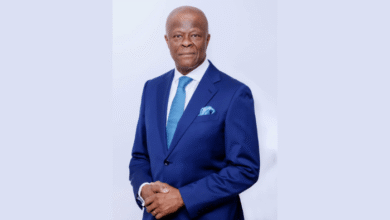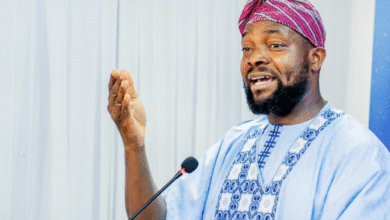Nigeria’s 2023 Budget Implementation Report, 2024 Budget and the Troubled State of Economic Assumptions

President Bola Tinubu’s plans to increase spending by a fifth in his first budget – a proposed spending plan that is roughly a fifth larger than 2023 budget in naira terms and it assumes an average inflation rate of 21%, an oil price of US$73.96 per barrel, and an average oil production of 1.78mb/d which it expects to help reduce the country’s debt-to-revenue ratio. The 2024 revenue, as formulated, is projected at N16.96trn, which is 54% higher than the 2023 budget, in absolute terms. Considering the revenue needed to fund the new budget, oil-related sources is projected to deliver 41%, while the remainder comes from non-oil-related sources; even as the financing for the deficit therein is outside the economic activity designed. The FGN’s share of non-oil tax is estimated at N3.52trn compared to N2.43trn in 2023, while its share of minerals and mining revenues is N4.56bn in 2024 from N3.64bn in 2023.
A familiar problem with the country’s development plans has been the wide gaps between its assumptions and outcomes. This has manifested itself in outcomes that reveal the budgets as stand-alone (single) trees obscuring a forest of programmes and policies that should drive productivity and growth. The absence of a whole-of-government approach to public sector management further worsens this lack of coherence between the budgets and the development plans. Analysts have observed that several ministries, departments, and agencies (MDA) consequently end up working at cross purposes, with activities of one department or agency cancelling out that of another or the actions of one minister making that of another ineffectual or problematic.
Given credence to this at the Nigerian Economic Summit Group (NESG) National Economic Summit (#NES29), the Governor of Jigawa State complained about how a private sugar production venture that should have started five years ago has been frustrated by the disagreement between the federal ministries of Agriculture and that of Water Resources. He noted that, while the Ministry of Agriculture and the State Government aligned with the investor’s preference for an open-water canal system that allowed farmers along the canal access to water that would provide irrigation for their sugar cane crops as contracted out-growers, the Ministry of Water Resources had insisted on the piping of water. The closed piping alternative would stretch the project beyond its breakeven period, taking it from five (5) to ten (10) years, thus leading to the cancellation of the agreement between the state/private investor and the local farming communities along the canal.
The tales from other sub-nationals follow a familiar pattern. Mining investors have discovered hurdles between thoughtful state value chains, and the federal oversight in the mining sector for example. Without a comprehensive approach to breaking down the walls of conflict between Federal Government MDAs and agencies in sub-nationals, private investors will continue to find themselves in a boiling pot of otherwise avoidable problems. For the 2024 budget to meaningfully aim at unleashing Nigeria’s productive essence, the governance gaps and policy conflicts must be addressed.
A Quick Peek at the MTEF 2024-2026
Considering the above reality, the Medium-Term Expenditure Framework (MTEF, 2024-2026) should, ordinarily, ensure discipline in resource allocation and macroeconomic stability of the Nigerian economy. But key parameters and assumptions of the framework suggest a GDP projection of 3.76% in 2024, 4.22% in 2025 and 4.78% in 2026 and the external reserves at $38.39bn, $41.95bn and $45.84bn in 2024, 2025 and 2026 respectively. The framework also projects that the money supply will maintain an upward trajectory to N95.64trn by 2026, while inflation will moderate to 18.6% in 2026. Analysts reckon that the rapid growth in the money supply will further fuel inflation, thereby hurting the currency and drying up reserves due to continuous intervention, suggesting that achieving a stable exchange rate and lower inflation might be murky.
Contrary to the administration’s earlier stance against borrowings, the MTEF projects new borrowings of N7.81trn, N8.54trn, and N10.07trn for 2024, 2025, and 2026. This suggests Nigeria’s debt will rise to around N114trn by 2026, given the current total public debt at N87trn as of Q2 2023, thus increasing the debt-to-GDP ratio higher than the current 41%. Consequently, debt servicing will increase, eroding the country’s revenue and external reserves through foreign debt obligations (See Table 1 below).
When one recalls that Nigeria’s growth periods have been achieved at an average of 7.5% to 8%; this budget plan assumes an average real GDP growth rate of 3.76% in 2024. This is concerning, especially when Nigeria’s real GDP growth rates have been below the projected budgetary rates in the last five years.
Inflation in the 2024 budget is assumed to be 21.4%. This figure represents a 24.71% rise in inflation projection compared with the 17.16% projection of the 2023 budget (currently at 26.7%, an 18-year high, up from 25.8% in August 2023). Given the inflationary trend over time, this figure is optimistic, and while it may reflect government’s hopeful intentions, it is unclear how the government arrived at the assumed figure. Furthermore, the trade, monetary and fiscal measures of the government have not complemented each other in achieving the goal of price stability in the economy. On the one hand, the monetary authorities have employed restrictive measures to curb the rising interest rates and on the other hand, fiscal measures continue to be expansionary with rising government spending and debt stock.
The oil price benchmark is set at US$73 per barrel of Brent crude, a cautious figure that accounts for the volatility that often characterizes the oil market. However, this benchmark of the Naira-to-dollar exchange rate may seem contentious at N700/US$. The low demand for Niara and higher demand for the dollar (a function as the dollar now acts as a store of value coupled with the high demand for imports needed for economic activities), is a major cause of the naira depreciation that persists. The rising production cost in the economy for businesses and high production cost and inevitably high price of goods in the economy. There is also a need for clear and specific measures to ensure rising forex inflows, which have been in short supply in the economy. According to the CBN, a major reason for the decline in forex inflow is the fall in foreign investment. Data from the CBN shows that forex inflows have been declining for the past three years. Nigeria’s exchange rate during these periods has experienced significant depreciation above the 2023 projected N435 per dollar. It is readily unclear how the budgetary provisions will be achieved at the assumed exchange rate in the 2024 budget.
The budget oil production for 2024 is 1.78mb/d. This represents a 5.32% rise compared to the 2023 projected oil production volume. According to the Nigerian Upstream Regulatory Commission, Nigeria’s production has hovered around 1.3mb/d but is currently at about 1.5mb/d which is still below the 1.69mb/d projected figure in the 2023 budget.
Chart 1:
2024 Budgetary Income
Nigerian policymakers expect a transformative year in 2024. Considering policy anchors in the 2024 budget, the government plans to combine borrowings with revenue generation. In the approved 2023 budget, N7.4trn was borrowed from the domestic market, with an additional N1.8trn from foreign sources. The 2024 has a projected expenditure of N26.01trn, marking a 19.15% increase from the 2023 budget. Deficit financing in 2024 is expected to take centre stage, primarily sourced from the domestic market, with a N6.0trn contribution towards the total deficit of N9.05trn. In contrast to reliance on Eurobonds and foreign borrowings, the domestic market is expected to carry a significant load share (See chart 2 below).
Chart 2:
Of Challenges and Opportunities
Over the years, Nigeria’s budget credibility has been doubtful, given the variances between projections and actual outcomes. The discrepancies arise from inaccurate budget assumptions/projections about macroeconomic indicators, especially exchange and inflation rates. Exchange rate volatility and rising inflation rates erode the purchasing power of budgeted funds, resulting in underperformance. For instance, the assumed 2023 budget inflation rate of 17.16% and an exchange rate of N437.57/US$ are total disconnect from the existing inflation rate of 26.72% for September 2023 and exchange rate of N793.34/US$ as of October 23, 2023. These contradicting figures can distort budget performance, with actual expenditure outrunning proposed expenditure and revenue.
Considering the extreme exchange rate volatility and rising inflation, this nagging disparity will likely persist for the 2024 budget. The naira has depreciated after liberalisation, falling to N1,350 at the parallel market as of October 23, 2023, due to severe FX scarcity. The chances of further depreciation are high as the country struggles with oil production, the major FX contributor. The country’s dependence on natural resources has exposed it to extreme volatility, hindering sustainable growth and development.
Comparison Between NDP and MTEF With The 2024 Budget
The assumptions underlying the 2024-2026 Medium-Term Expenditure Framework indicate that the economic growth rate over the next three years will be higher than the modest rates recorded since the end of the recession in 2020. Accordingly, economic growth is projected to increase to 3.76%, 4.22% and 4.78% in 2024, 2025 and 2026, respectively, mainly due to strong political will to take tough decisions and implement necessary reforms.
Both the MTMEF and the NDP project a downward trend in inflation, with the MTMEF forecasting higher values than the NDP. The assumed budget 2024 aligns with the higher inflation rate projected in the MTMEF, suggesting potential risks to price stability. The NDP anticipates a consistently higher GDP growth rate than the MTMEF from 2024 to 2026. The assumed budget 2024 aligns more closely with the MTMEF projection, indicating a potential discrepancy in growth expectations.
The disparities in projected oil prices and production levels between the MTMEF, the NDP, and the assumed budget indicate potential variations in the underlying assumptions related to the global oil market, production capabilities, and demand-supply dynamics. This might lead to uncertainties in revenue forecasts and resource allocation. The assumed budget for 2024 appears to align more closely with the MTMEF projections than with the NDP, implying potential policy continuity in line with the medium-term framework. However, the higher inflation rate in the assumed budget may warrant closer monitoring and potential policy adjustments to ensure price stability.
Given the projected trends, it’s crucial for policymakers to focus on strategies to diversify the economy and reduce dependency on oil. Strengthening non-oil sectors, encouraging investments, and promoting sustainable growth are critical to mitigate risks associated with oil price fluctuations and ensure long-term economic stability. Effective fiscal management is essential to accommodate the variations in key economic indicators. Continual monitoring and appropriate adjustments in fiscal policies are crucial to maintaining a balance between growth, inflation, and overall economic stability, especially when dealing with volatile commodities such as oil.
Analysts Thoughts
It may be therefore fair to say that President Bola Tinubu’s wishful thoughts expressed to the business community at the #NES29 on Monday that Nigeria’s economy can grow to $1 trillion by 2026; and that a $3 trillion Nigerian economy is possible in 10 years; are not stepped in or aligned with the government’s national plans.
The administration is pursuing a contradictory and unsustainable economic plan and policy that will not only worsen the debt burden of the country but also worsen the living conditions of Nigerians if the development plans do not address the productivity concerns in our sovereign finances. By borrowing more than the economy can produce and setting unrealistic assumptions, the new government is creating a vicious cycle of debt servicing and deficit financing that will further erode the value of the naira and the purchasing power of the people.
The medium-term expenditure framework ignores the fundamental causes of inflation and exchange rate instability. Inflation in Nigeria is currently, largely driven by high money supply growth, low productivity, supply shocks, and exchange rate depreciation. The plan to increase the money supply by more than 50% within three years without addressing other issues will increase inflationary pressure and weaken the naira further, contradicting the projected moderation in inflation. The assumption that the exchange rate will strengthen to N669/US$1 by 2026 despite having low productivity, low foreign reserves, high trade deficit, and low investor confidence is also rather presumptuous for economic logic.
The proposed 2024 budget also has a lot riding on the fiscal expertise of the fresh economic helmspersons that form different parts of the president’s Decagon of Power. This budget lays down the philosophical and economic markers of the Tinubu administration; yet there has not been any radical change in the basis of assumptions that underpin and set the tone for the broad policy direction and outcomes sought for the economy.
The assumption of lower domestic inflation indicates monetary policy tightening between Q4 2023 and 2024, with money supply growth (M2) declining and the monetary policy rate remaining in the upper double digits. Higher dependence on the domestic fixed-income market to fund the budget deficit would mean lower bond prices on the back of higher coupon rates. Institutional investors would likely increase the proportion of government debt in their portfolios. The consequence would be the crowding out of commercial private-sector lending by banks.

Higher domestic interest rates in 2024 may result in worsening credit rationing and a slower GDP growth rate despite the government’s moderately paced growth target of 3.76%. Higher interest rates would equally mean a rise in the government’s domestic cost of borrowing. To address this, the government may be tempted to reduce banks’ cash reserve ratios (CRR) from 32.5% (this year, the government reduced the CRR from 32.5% to 10% for merchant banks to improve long-term lending). Nevertheless, this would contradict its tighter monetary policy goal. In other words, the government in 2024 will have to resolve its economic trilemma by choosing its battles.




